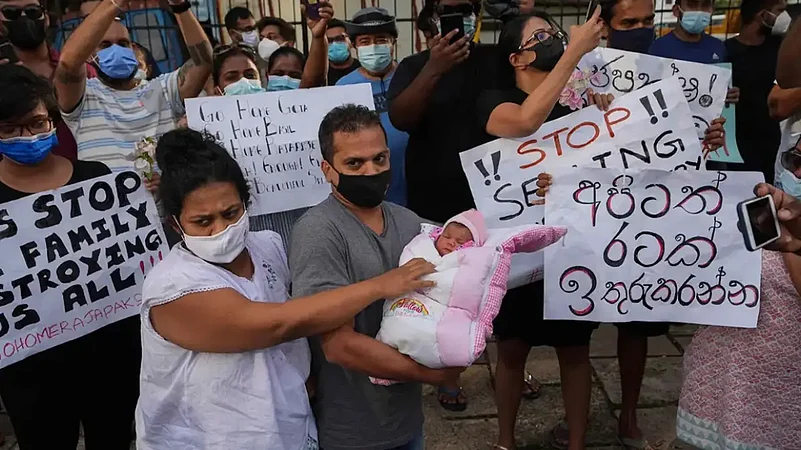Riveting images in pictures and videos coming through from Sri Lanka tells a powerful story of people’s power.
The shots capture the profile of the protesters: young and exuberant, angry and jubilant, coming out in the scorching sunshine to send a message to the rulers: We have had enough, we want to reclaim our country from your greed, your corruption, your machinations will no longer work. Whether the movement finally rejuvenates and transforms this divided nation of over 22 million people will unfold in the coming days. But for now, the gaol of getting the Rajapaksas out has succeeded.
"Gota Go Home" the hashtag under which the protests first began had drawn thousands of frustrated and angry people on to the capital’s sea front in Galle Face Green, Colombo’s version of Cairo’s Tahrir Square.
According to Jayadeva Uyangoda, well know political commentator, the phrase was coined on March 31, by a group of urban, English speaking middle class protesters. "The catch phrase captured the imagination of the people and everybody -- Sinhala, Tamil and English speaking people -- began to shout it in its original form in English," Uyangoda said.
The young people, many of them from the universities, both boys and girls, were on the frontline. Stomping their feet, some with clenched fists, threatened the established order, for the moment epitomised by Gotabaya. Protest songs reverberated as people called for change. There were instances when the "Bella ciao" the protest song of the Italian peasants were also heard. Snatches of songs sung by Che Guevara’s guerrillas were popular with the more radical elements among the protesters. Carrying the Sri Lankan flag, many wearing colourful bandanas and armed with placards, the people were determined not to allow Gotabaya Rajapaksa to continue in power. His brother, the former president Mahinda Rajapaksa, had to quit as prime minister. The rest of the clan had also quit by April, but Gotabaya continued his political machinations. He appointed Ranil Wickremesinghe as his new Prime Minister and hoped it would give him some reprieve, and gradually the movement would dissipate. But that was not to be.
The final blow came on Saturday, July 9, when the protesters arrived in trains and buses and by foot to gather in front of the official residence of the President. Steely eyed policemen wearing helmets and carrying batons descended to the Fort Area where the President's home was located. As the crowds swelled and became more agitated they lunged forward breaking the barricades and swarmed into Gotabaya’s home. But the President had already escaped the night before and was taken to a secret location by the defence forces.
Once inside the presidential palace, the crowds went berserk. People jumped into the pool, sat on the plush sofas and marvelled at the lifestyle of their ruler. Another section of the demonstrators burnt down the private home of prime minister Ranil Wickremasinghe. His library of 2,500 books contained several limited editions and rare copies of books. He also owed several rare paintings that were also destroyed by the fire.
The government too swung into action. Tear gas and batons were used to disperse the crowds. People helped each other as they scrambled to get away from the tear gas shells lobbed by the police. Hundreds were injured including demonstrators, police and journalists covering the events. But the protests finally achieved what they had set out to do initially. The President promised at long last to step down.
The crowds erupted with joy when the news trickled in on July 14, that Gotabaya Rajapaksa who fled the country under cover of darkness finally sent-in his resignation. Despite the celebrations, anger was also palpable. One young man lamented that the President had escaped without punishment for his misdeeds.
"He has slunk away like a rat after looting the country and destroying our economy. I want him to come back and face trial for his misdeeds,’’ the student said in one of the clips that have been making the rounds.
But there were many happy clips too. One was of a young couple in sharing a passionate kiss after news of Gotabaya’s resignation.
Organisers
The movement may have been started by a few committed activists and got maximum support from the youth and long suffering ordinary citizens struggling to make ends meet. Lawyers across Sri Lanka and the Supreme Court Bar Association played their part in sustaining the movement especially in rural areas where farm protests were ruthlessly crushed and the protesters arrested. This was before the main events in March. Despite the best efforts of a section of the protesters to keep the movement free of politicians that was not the case.
Left-Wing Politicians
There are several Left-wing political elements as well. These are:
The Janatha Vimukhti Peramuna (JVP) once a violent ultra-Left group which since the death of its leader Rohana Wijeweera in 1989, has renounced violence and has been contesting elections. The Frontline Socialist Party (FSP), the National Peoples Power (NPP) are all left-leaning groups.
The Inter University Students Federation (IUSF), the largest student organisation in the island with 70 students unions across the country affiliated to it have also played a major role. The movement was united under one slogan, Gota Go Home. However, there is a difference between the ordinary people and the left supporters of the movement, supported by the students. The political elements want a complete transformation of the country and a new social and political contract, including a brand new Constitution for the country. Traditional politicians including members of Parliament are now discredited. What next remains to be seen.
















